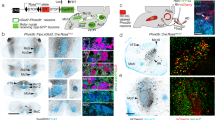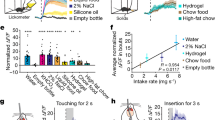Abstract
-
1.
We have studied the neural circuitry mediating ingestion and rejection in Aplysia using a reduced preparation that produces ingestion-like and rejection-like motor patterns in response to physiological stimuli.
-
2.
We have characterized 3 buccal ganglion motor neurons that produce specific movements of the radula and buccal mass. B8a and B8b act to close the radula. B10 acts to close the jaws and retract the radula.
-
3.
The patterns of activity in these neurons can be used to distinguish the ingestion-like and rejection-like motor patterns. B8a, B8b and B10 are active together during the ingestion-like pattern. Activity in B8a and B8b ends prior to the onset of activity in B10 during the rejection-like pattern.
-
4.
Our data suggest that these neurons undergo similar patterns of activity in vivo. During both feeding-like patterns, the activity and peripheral actions of B8a, B8b, and B10 are consistent with radula movements observed during ingestion and rejection. In addition, the extracellular activity produced by these neurons is consistent with neural activity observed in vivo during ingestion and rejection.
-
5.
Our data suggest that the different activity patterns observed in these motor neurons contribute to the different radula movements that distinguish ingestion from rejection.
Similar content being viewed by others
Abbreviations
- BN2:
-
buccal nerve 2
- RN:
-
radula nerve
- EJC:
-
excitatory junction current
- SCP:
-
small cardioactive peptide
- EMG:
-
electromyogram
References
Chiel HJ, Susswein AJ (1993) Learning that food is inedible in freely behaving Aplysia californica. Behav Neurosci 107:327–338
Chiel HJ, Weiss KR, Kupfermann I (1986) An identified histaminergic neuron modulates feeding motor circuitry in Aplysia. J Neurosci 6:2427–2450
Church PJ, Lloyd PE (1991) Expression of diverse neuropeptide cotransmitters by identified motor neurons in Aplysia. J Neurosci11:618–625
Church PJ, Cohen KP, Scott ML, Kirk MD (1991) Peptidergic motoneurons in the buccal ganglia of Aplysia californica: Immunocytochemical, morphological, and physiological characterizations. J Comp Physiol A 168:323–336
Croll RP, Davis WJ (1981) Motor program switching in Pleurobranchaea. I. Behavioural and electromyographic study of ingestion and egestion in intact specimens. J Comp Physiol 145:277–287
Croll RP, Davis WJ, Kovac MP (1985a) Neural mechanisms of motor program switching in the mollusc Pleurobranchaea. I. Central motor programs underlying ingestion, egestion, and the “neutral” rhythm(s). J Neurosci 5:48–55
Croll RP, Kovac MP, Davis WJ (1985b) Neural mechanisms of motor program switching in the mollusc Pleurobranchaea. II. Role of the ventral white cell, anterior ventral, and B3 buccal neurons. J Neurosci 5:56–63
Croll RP, Kovac MP, Davis WJ, Matera EM (1985c) Neural mechanisms of motor program switching in the mollusc Pleurobranchaea. III. Role of paracerebral neurons and other identified brain neurons. J Neurosci 5:64–71
Cropper EC, Kupfermann I, Weiss KR (1990a) Differential firing patterns of the peptide-containing cholinergic motor neurons B15 and B16 during feeding behavior in Aplysia. Brain Res 522:176–179
Cropper EC, Price D, Tenenbaum R, Kupfermann I, Weiss KR (1990b) Release of peptide cotransmitters from a cholinergic motor neuron under physiological conditions. Proc Natl Acad Sci USA 87:933–937
DiCaprio RA (1985) Neural correlates of reversed ventilation in the shore crab. Am Zool 25:52A
DiCaprio RA (1989) Nonspiking interneurons in the ventilatory central pattern generator of the shore crab, Carcinus maenas. J Comp Neurol 285:83–106
DiCaprio RA (1990) An interneurone mediating motor programme switching in the ventilatory system of the crab. J Exp Biol 154:517–535
Dickenson PS, Mecsas C, Marder E (1990) Neuropeptide fusion of two motor-pattern generator circuits. Nature 344:155–158
Gardner D (1971) Synaptic organization and bilateral symmetry in the buccal ganglia of Aplysia. Ph D Thesis, New York University
Gelperin A, Chang JJ, Reingold SC (1978) Feeding motor program in Limax. I. Neuromuscular correlates and control by chemosensory input. J Neurobiol 9:285–300
Getting PA, Dekin MS (1985) Tritonia swimming: a model system for integration within rhythmic motor systems. In: AI Selverston (ed) Model neural networks and behavior. Plenum, New York, pp 3–20
Hooper SL, Moulins M (1989) Switching of a neuron from one network to another by sensory-induced changes in membrane properties. Science 244:1587–1589
Kandel ER (1979) Behavioral biology of Aplysia. Freeman, San Francisco
Kupfermann I (1974) Feeding behavior in Aplysia: A simple system for the study of motivation. Behav Biol 10:1–26
Kupfermann I, Carew TJ (1974) Behavior patterns of Aplysia californica in its natural environment. Behav Biol 12:317–337
Kupfermann I, Teyke T, Rosen SC, Weiss KR (1991) Studies of behavioral state in Aplysia. Biol Bull 180:262–268
Lloyd PE, Mahon AC, Kupfermann I, Cohen JL, Scheller RH, Weiss KR (1985) Biochemical and immunocytochemical localization of molluscan small cardioactive peptides in the nervous system of Aplysia californica. J Neurosci 5:1851–1861
McClellan AD (1982a) Movements and motor patterns of the buccal mass of Pleurobranchaea during feeding, regurgitation, and rejection. J Exp Biol 98:195–211
McClellan AD (1982b) Re-examination of presumed feeding motor activity in the isolated nervous system of Pleurobranchaea. J Exp Biol 98:213–228
Morton DW, Chiel HJ (1991) Two patterns of buccal nerve activity that distinguish ingestion from rejection can be replicated in a reduced preparation in Aplysia. Soc Neurosci Abstr 17:1593
Morton DW, Chiel HJ (1992) A motor basis for the radula movements underlying ingestion and rejection in Aplysia. Soc Neurosci Abstr 18:1056
Morton DW, Chiel HJ (1993) In vivo buccal nerve activity that distinguishes ingestion from rejection can be used to predict behavioral transitions in Aplysia. J Comp Physiol A 172:17–32
Morton DW, Chiel HJ, Cohen LB, Wu J-Y (1991) Optical methods can be utilized to map the location and activity of putative motor neurons and interneurons during rhythmic patterns of activity in the buccal ganglion of Aplysia. Brain Res 564:45–55
Nagahama T, Takata M (1988) Food-induced firing patterns in motoneurons producing jaw movements in Aplysia kurodai. J Comp Physiol A 162:729–738
Nagahama T, Takata M (1989) Neural mechanism generating firing patterns in jaw motoneurons during the food-induced response in Aplysia kurodai. I. Identification and characterization of premotor neurons. J Comp Physiol A 166:143–150
Nagahama T, Takata M (1990) Neural mechanism generating firing patterns in jaw motoneurons during the food-induced response in Aplysia kurodai. II. Functional role of premotor neurons on generation of firing patterns in motoneurons. J Comp Physiol A 166:277–286
Plummer MR, Kirk MD (1990) Premotor neurons B51 and B52 in the buccal ganglia of Aplysia californica: synaptic connections, effects on ongoing motor rhythms, and peptide modulation. J Neurophysiol 63:539–558
Ram JL, Young ES (1992) Shock induces a long lasting elevation of blood glucose in Aplysia. Experientia 48:14–18
Robertson GA, Stein PSG (1988) Synaptic control of hindlimb motoneurons during three forms of the fictive scratch reflex in the turtle. J Physiol (Lond) 404:101–128
Rosen SC, Weiss KR, Cohen JL, Kupfermann I (1982) Interganglionic cerebral-buccal mechanoafferents of Aplysia: receptive fields and synaptic connections to different classes of neurons involved in feeding behavior. J Neurophysiol 48:271–288
Rosen SC, Teyke T, Miller MW, Weiss KR, Kupfermann I (1991) Identification and characterization of cerebral-to-buccal interneurons implicated in the control of motor programs associated with feeding in Aplysia. J Neurosci 11:3630–3655
Scott ML, Govind CK, Kirk MD (1991) Neuromuscular organization of the buccal system in Aplysia californica. J Comp Neurol 312:207–222
Selverston AI, Moulins M (1987) The crustacean stomatogastric system. Springer, Berlin Heidelberg New York
Sossin WS, Kirk MD, Scheller RH (1987) Peptidergic modulation of neuronal circuitry controlling feeding in Aplysia. J Neurosci 7:671–681
Susswein AJ, Byrne JH (1988) Identification and characterization of neurons initiating patterned neural activity in the buccal gangliaof Aplysia. J Neurosci 8:2049–2061
Susswein AJ, Schwarz M, Feldman E (1986) Learned changes of feeding behavior in Aplysia in response to edible and inedible foods. J Neurosci 6:1513–1527
Weimann JM, Meyrand P, Marder E (1991) Neurons that form multiple pattern generators: Identification and multiple activity patterns of gastric/pyloric neurons in the crab stomatogastric system. J Neurophysiol 65:111–122
Weiss KR, Chiel HJ, Koch U, Kupfermann I (1986) Activity of an identified histaminergic neuron, and its possible role in arousal of feeding behavior in semi-intact Aplysia. J Neurosci 6:2403–2415
Author information
Authors and Affiliations
Rights and permissions
About this article
Cite this article
Morton, D.W., Chiel, H.J. The timing of activity in motor neurons that produce radula movements distinguishes ingestion from rejection in Aplysia . J Comp Physiol A 173, 519–536 (1993). https://doi.org/10.1007/BF00197761
Accepted:
Issue Date:
DOI: https://doi.org/10.1007/BF00197761




